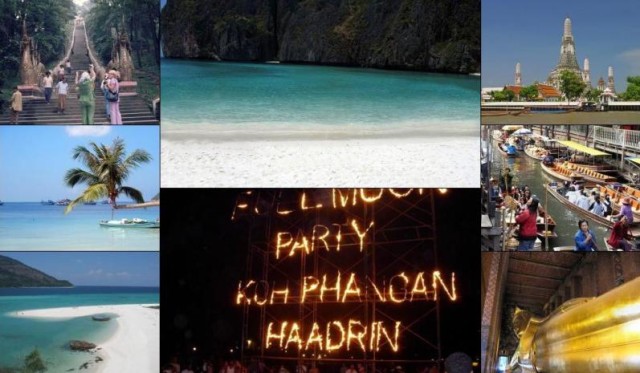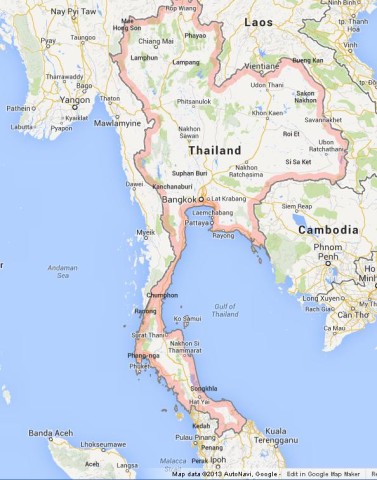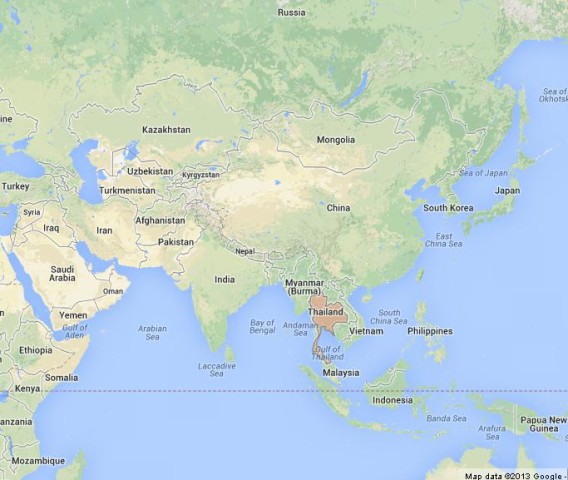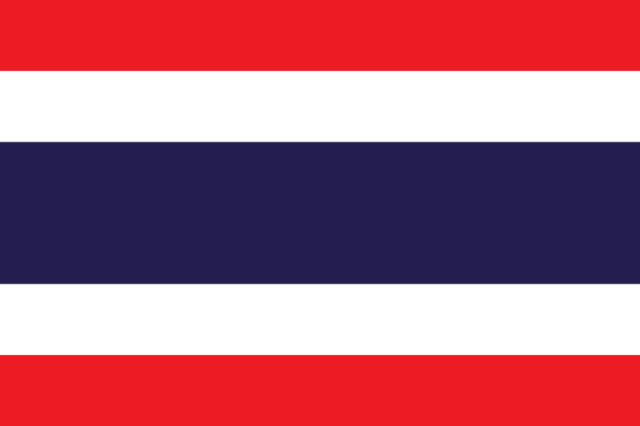Main Cities
Islands of Thailand
Important Places in Thailand
Highlights of Bangkok
Map of Thailand
Where is Thailand on Map of Asia
Flag of Thailand
Thailand: the country of the free people
What makes Thailand one of the most frantic, vibrant, exciting, energetic and creative nations in Asia today? Apart from its magnificent landscapes and exuberant fertility, the Thai history and culture reflect the rich artistic heritage of a magnificent kingdom. The identity of the kingdom continues to grow and evolve, not iust adapting to contemporary trends, but olso making its own brand in the world today. What makes Thailand so strong a presence in the region? On the one hand, Thailand has the distinction of being the only Southeast Asian country that was never colonized by a foreign power and that is very important. There were repeated attempts of invasion by the Burmese in ancient times, and the brief Japanese occupation during World War II, Thailand has always been, as its name, the Land of the Free. Thailand escaped European colonization through the intelligence of their rulers, who tolerated foreigners, threw them against each other, and marketed marginal land in Laos and Cambodia to safeguard the independence of Thailand. While maintaining an attitude of openness to other cultures, the Thai nation has always had its own sense of pride and cultural identity. Thai people have a spirit of patriotism and independence, as well as closely enthusiasm for life. His reverence for all forms manifests itself as soft on compassion to animals and other humans, and the passion displayed in food, arts, faith and work.
The Land of Smiles
The Land of Smiles derives from the famous Thai smile that characterized his people. Beyond the smile, another main feature of thai, is the sense of fun that they call, Sanuk, what the French call joie de vivre. The joy of thai, it is natural, is genuine, making their lives happier and no complaints. Culture is a social process, with a tradition of family and community, and a society where great importance is placed in a customs and speech in relation to others. Because of their great love of the community, the Thai people have fun in social interaction, noise and bustle. In contrast to the European perspective, the thought of being alone, or traveling and dining alone in a foreign land, is considered a sad case for Thai kindred love. The Thais are renowned for their kindness and courtesy in all situations. Pride thai is present in the smile, smiling masks to any negative or distressing situation. Thai is a very difficult, to say no, the answer is always yes, “You have some bananas? Yes, I have no bananas.”
A key element of Thai culture is great respect for religion, the monarchy, the elders, and family. In every social stratum, from the lowliest servant to the noble aristocrat, the Thai people practice a natural education and grace that is unfailingly attractive and always pleasant. Thai culture reveres the head as the highest and most sacred body. Thus, in Thailand, never touches the head of other person, is considered shockingly rude.
Festivals and Fun
Sanuk (thai word to describe fun) is evident in the numerous festivals and competitions throughout the year across the country. In fact, there is at least one and sometimes two, holidays every month. Only in June and September, have no holidays. The biggest festival and a favorite for thai people is Songkran, the water-throwing event celebrating the Thai New Year in mid-April, during the hottest weeks of the year. There is no religious significance to this festival – it’s just a fun, chilling way to inaugurate the New Year. The whole country can join. In Bangkok and Chiang Mai, revelers ride pick-up trucks with buckets of water pistols and giant water to douse all the passersby, screaming with pleasure. One of the most beautiful festivals, is Loy Krathong. Celebrated during the season in November full moon, small floral floats made of banana leaves and flowers, decorated with incense and candles, are sent to the wishes in the streams and rivers. It’s a beautiful sight to see and hits a note, romantic magic when held in the ruins of moonlight, the Sukhothai and Ayutthaya.
Spirituality as centre of life
The Thai calendar is peppered with religious holidays in honor of the main events of Buddha’s life. Reverence for the Buddhist faith one of the strongest principles of Thai culture and permeates all aspects of behavior and thought This is evident in the large number of temples in each city or village. No Thai community, be it a hub of a metropolitan or rural village, is complete without the presence of a temple to serve society In traditional societies, the temple is the center of life, playing multiple roles as a religious center, healing center, school, orphanage, meeting place, playground, place of the village fairs, festivals and even a place for homeless animals. The tranquility of the Thai people and calm disposition is seen as a result of its strong ties to the Buddhist faith, which places emphasis on mindfulness, nonviolence and compassion. The Thais believe the acquisition of merit in this life to ensure that during his next rebirth, they are reincarnated into a better life. Hope for a good reincarnation is obtained by making offerings in the temple, giving alms to monks, or in the case of males, becoming a monk for a short period. In Thai culture, every man is expected to take monkhood at some point in your life. Monk is not a fixed state, and can last a week or a period. It used to be a rite of passage between the time a man left school and started a career, or get married. These days, a period of monastic life orten performed when a parent has died, to make merit for the deceased, as well as the rest of the family.
Spirit Houses
A feature unique to Thai culture is the “spirit house”, surrounded by offerings of food, incense and flowers, and visible in many homes and office buildings. Spirit Houses are usually draw small structures like miniature wooden houses, or in case of office buildings, construction of cement imitating Khmer temples. Thais believe that the land is protected by guardian spirits, so when a new house or building is erected, the human occupants must provide a spiritual home for the spirits to live offerings doily must be made to keep them happy. in return, the spirits will protect the occupants and bring them peace and security. In the case of office buildings, it is expected that the spirits will bring financial success. Spirit houses should not be neglected, otherwise the discontented and hungry spirits may decide to cause harm or bring bad luck to the premises.
The Spa in Thailand
The spiritual traditions of Thailand have helped develop the concept spa in all of Asia, with thai spa in the center. The incredible appeal is linked to the traditions of the country, the only cure, in which mental and spiritual well-being is derived from Buddhist practices that were part of Thai life for centuries. In Thailand, exclusive treatments offered in spas today are derived from ancient Thai ritual of natural healing such as traditional healing massage, herbal baths and compresses. These gentle methods were developed from the ancient Indian Ayurvedic medicine who migrated from India with the Buddhist missionary monks, in the second and third centuries. The monks were the healers during these times. Even now, modern body treatments based on plants are formulated from centuries of indigenous health and beauty habits. Thai spa treatments are performed with the innate sweetness of Thai people. It is the extra dimension of dielectric in Thai spa experience that makes you feel so deliciously pampered. The spa has a huge impact on visitors. Many Thai spas are set in the exotic beach and mountain environments, with beautiful natural surroundings, making the whole spa experience very special. They are increasingly sophisticated and creative in its interior design too. Some spas offer impressive design concepts that you will not find elsewhere. Thailand is in fact home to a wide range of spa styles and services, ranging from the ultra-luxurious to rustic base.
Food fusion in the true thai style
In the heart of thai culture is the food. It is no mystery why the whole country is obsessed with good food, the kitchen is simply full of variety and flavor. Eating is not limited to three times daily throughout the day, eat even if a small snack. Those visiting Thailand is amazed by the flavors and diversity, abundance and all the amazing thai cuisine. The thai dishes have influences from India and China, but the thai food, has preserved its own identity. The fresh and fragrant herbs are always present. The Padthai is always present in a street food stall and visitors, grateful for.
A Lasting design tradition
The architectural heritage and the arts of Thailand, who have reached the splendor today through royal patronage over the centuries. The opulence and shiny golden spiers of the architecture of the classical temple, were developed during the Ayutthaya and Rattanakosin eras, such structures were a true reflection of prosperous kingdoms in the country. Thai Buddha, is identified by its stylized and calm in its expression. Over the centuries, the images of the buddha thai forged his own stylistic identity. The Sukhothai Buddha, his face is more elongated, curved, arched eyebrows and nose long and pointed. The global view evokes a sinuos androgyny, which seems more abstract than body. The Sukhothai style Buddha is also known for walking away from the traditional seated Buddha. The usual Thai motifs, are unique, the triangle is a favorite. The triangle is present in wooden houses, in cupboards, in the triangular pillows and other objects. The lotus flower also predominates in the decor thai. With the profusion of exotic flowers, it is natural that the floral decoration is other forms of decorative art in Thailand. In temples, the tradition of flowers, was passed from generations ago.
Contemporary Thai Chic
The Thailand is leading the wave of contemporary Asian style in food, art, fashion and decoration. There are plenty of magazines in the street stalls, working on issues of lifestyle, not only publications but also thai international magazines in search of his room in the market thai. There are Thai-language editions of Elle and Elle Decor magazines that have become famous in Bangkok. Also, Cosmopolitan, Esquire, Cleo, Marie Clare, Harpers Bazaar and Madame Figaro published in Thai. The Thai nation has always been able to assimilate outside influences and relates them with their unique cultural identity. The thai are masters of mimicry, with inspirations foreign, craftsmen have created works splendors mixing with the touch thai. The fusion cuisine is a good example, there is a strong tendency to create a mixing bowl thai cuisine, with Italian food. Those who visit Thailand, falls in love with its landscape, culture, arts and cuisine. The style thai is leaving its mark around the world. What began as the spread of influence in thai cuisine, expanded into the fashion and contemporary decor. There is a group of talented designers thai, which already win prizes abroad. Jim Thomson, an American world-famous, helped revitalize the thai silk in the world. His house in Bangkok, is part of the tourist routes. Its collections are authentic models of inspiration. The Thai government has made great efforts to promote the fashion thai in the world, more and more local brands that became internationalized as Nogara, Metto, Greyhound, Senodo, Kloset, Anurok, Zenith, Tube Gallery, Fly Now, Moe Fah Luang and Tango.
The Art Scene is growing
The art in Thailand is to move from traditional to contemporary. The artists thai recently started to gain international visibility. In 2005, Araya Rasdjarmrernsook and Montien Boonma attended the Venice Biennale, the world’s most prestigious international art show. In Bangkok there are many galleries specializing in modern works of Thai and Asian artists such as Carpe Diem Galleries, Gallerie 55, Surapon Gallerie and others. There is now a trend of showing art in restaurants and pubs.
Holidays on the eastern seabord
The Gulf of Thailand has always been a place to escape from Bangkok residents. Being closer to the east coast has been the most chosen, especially Pattaya and Ko Samet. A little over an hour paradise is right next to the great metropolis. Hua Hin on the opposite side is also often chosen.
Classic Houses
The Thai architecture distinguishes itself in temples and stylish homes. The style ranges in the North, the South and the Central Plains but never lose their charm. Traditionally Thai communities living near rivers, houses were built on stilts or on boats. The river plains are flooded during monsoons. All the houses had large outdoor balconies, where social and ate under the shade of trees. They were built without nails to be easily removable, like a puzzle. Times have changed and in big cities like Bangkok, there are few homes with these features.



